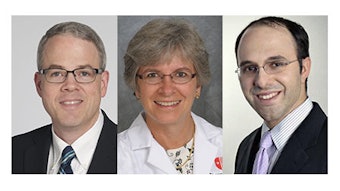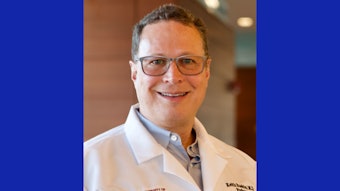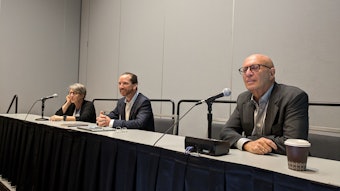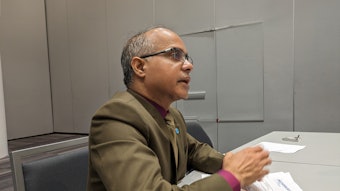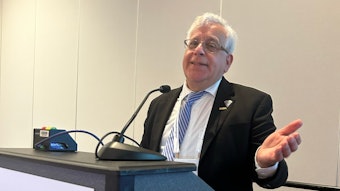In or out?
Outpatient joint replacement arthroplasty remains controversial.
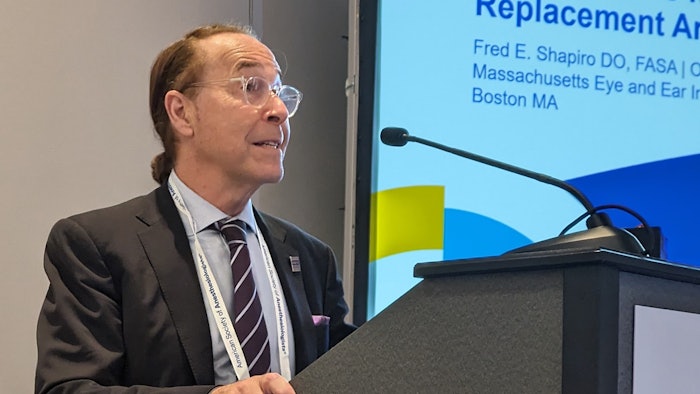
Outpatient joint replacement arthroplasty is growing in popularity among patients and surgeons alike. But there is still plenty of debate over safety, how much money it saves, and what kind of anesthesia is best suited for it.
Ashley Shilling, MD, Associate Professor of Anesthesiology and Orthopedic Surgery at University of Virginia Medical Center in Charlottesville, said that, while the definition of outpatient joint replacement arthroplasty can vary depending on whether the patients go home the same day or the next day, one thing remains certain: there are no pros to this kind of surgery unless certain conditions are met.
Those conditions include patient buy-in, patient selection, competency in preop preparation and education, facility resources, skilled surgeons, skilled anesthesiology teams, pain management techniques, patient and family education throughout the process, and social support.
Dr. Shilling said there are plenty of studies showing that outpatient replacement arthroplasty is safe, but with one crucial element above all the others.
“The caveat is if the appropriate patients are selected for outpatient joint arthroplasty,” she said. “Without this, there are no benefits of outpatient arthroplasty, so this is critical.”
Appropriate patients, Dr. Shilling explained, are those without certain risk factors that include being older than age 75, having a body mass index greater than 35, or a preexisting condition such as COPD or cirrhosis.
Another question that arises when considering this kind of outpatient surgery is what kind of anesthesia is best to use. Alberto E. Ardon, MD, MPH, Assistant Professor of Anesthesiology at the Mayo Clinic in Jacksonville, Florida, said it is more critical now than ever for anesthesiologists to develop a plan for dealing with outpatient arthroplasty.
“This is becoming more and more frequent, so we have to be familiar with the anesthetic plan we are going to use for these patients,” he said.
Part of that plan might involve deciding between a spinal anesthetic (SA) and a general anesthetic (GA). Dr. Ardon said that although there is not a lot of literature in this area, there are benefits and drawbacks to both. These include length of stay, which will be longer with an SA and shorter with a GA, and lower incidents of late postoperative pain with GA compared to SA.
“The question is, really importantly, what anesthetic are we going to choose?” Dr. Ardon said. “And based on our most recent systematic reviews, I would venture to say probably the number-one thing that we’re finding is that we don’t have a lot of strong evidence in the literature. But I can tell you from personal experience from a lot of my colleagues that mepivicaine is a way to go for this. If you have a fast enough surgeon, bupivicaine can also be useful. What you want to do is avoid the pivot game, and the reason is you never know what the expected duration is for this medication in terms of postoperative physical functioning.”
The last question that needs to be addressed regarding this type of surgery is cost. Jagan Devarajan, MB, BS, FASA, Clinical Associate Professor of Anesthesiology at Cleveland Clinic in Ohio, said that the biggest cost driver for these procedures is the implant itself, followed by the discharge destination (hospital or home), complications, inpatient care, and rehabilitation. However, outpatient procedures in an ambulatory care facility as opposed to a hospital can reduce the costs dramatically.
“In an ambulatory setting, we can make it more efficient and significantly bring the cost down,” he said. “And, also, we have found that if a patient had physical therapy before the surgery, that significantly decreases the cost because the patient has a better recovery and they have less of a chance of having a prolonged physical therapy after the surgery.”
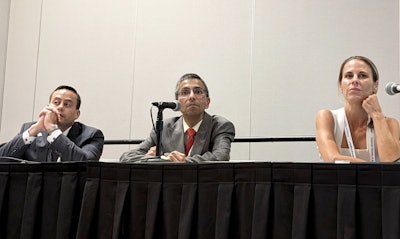 Alberto E. Ardon, MD, MPH, Jagan Devarajan, MB, BS, FASA, and Ashley Shilling, MD
Alberto E. Ardon, MD, MPH, Jagan Devarajan, MB, BS, FASA, and Ashley Shilling, MD
